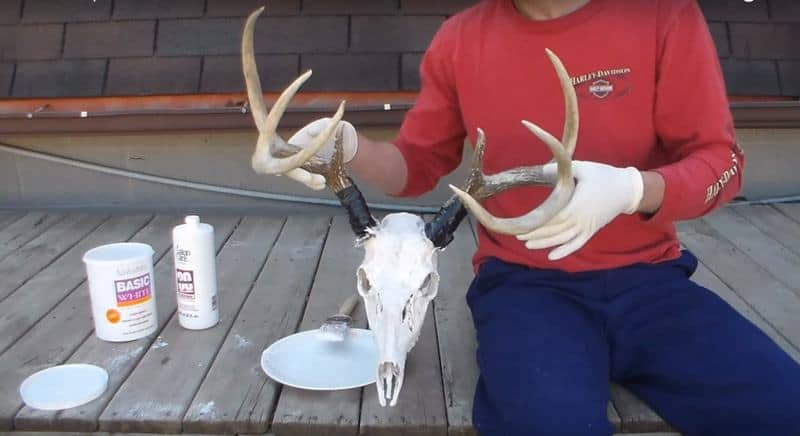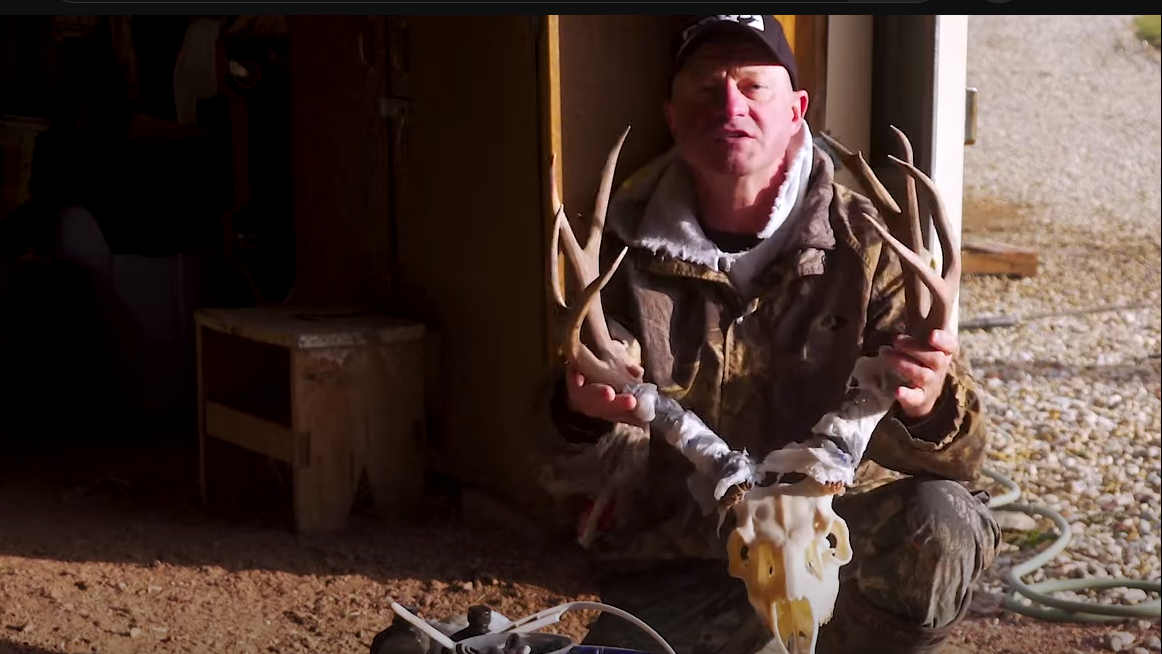In the realm of taxidermy and hunting, borax for deer skull preservation has become an indispensable tool, offering a safe and effective way to keep your prized trophies looking their best. Whether you’re a seasoned hunter or an aspiring artist, understanding the intricacies of borax application can help you achieve stunning results.
Borax, a naturally occurring mineral, plays a crucial role in preserving deer skulls by inhibiting the growth of bacteria and insects. Its unique properties make it an ideal choice for long-term skull preservation, ensuring that your trophies remain intact and free from decay.
Introduction
Borax, also known as sodium tetraborate, is a naturally occurring mineral that has found diverse applications in various industries, including the preservation of organic materials. In the context of wildlife biology and hunting, borax plays a crucial role in preserving deer skulls, ensuring their longevity and enabling their use for scientific study, hunting trophies, and artistic endeavors.
Borax is a great way to clean and preserve deer skulls, but did you know that it can also be used to clean the skulls of other animals, like the calamian hog deer ? This small deer is native to the Philippines and is known for its distinctive black and white coat.
Like other deer, its skull can be cleaned using borax. The process is the same as for deer skulls, and the results are just as impressive.
Skull preservation is of utmost importance for several reasons. In scientific research, well-preserved skulls provide valuable data for studying the anatomy, morphology, and evolution of deer species. They serve as reference specimens for comparative analyses, aiding in the identification and classification of different species.
Moreover, preserved skulls are essential for understanding the ecological relationships between deer and their environment, including their feeding habits, habitat preferences, and population dynamics.
Deer Skull Preservation Using Borax
The use of borax for deer skull preservation has gained widespread acceptance due to its effectiveness and ease of application. Borax acts as a natural preservative by inhibiting the growth of bacteria and fungi, which are the primary agents responsible for the decomposition of organic matter.
The process of preserving a deer skull using borax is relatively straightforward and involves several steps:
- Cleaning the Skull:Remove any remaining flesh or tissue from the skull using a sharp knife or scalpel. It is crucial to remove as much organic matter as possible to prevent decomposition.
- Soaking in Borax Solution:Prepare a saturated borax solution by dissolving borax powder in hot water until no more powder can be dissolved. Submerge the skull in the solution and allow it to soak for several days, ensuring that it is completely covered.
- Drying the Skull:After soaking, remove the skull from the solution and allow it to dry thoroughly in a well-ventilated area. Avoid exposing the skull to direct sunlight, as this can cause the bones to warp or crack.
Once the skull is completely dry, it is considered preserved and can be stored indefinitely in a cool, dry place. Preserved deer skulls are valuable specimens that can contribute to scientific research, serve as hunting trophies, or be used for artistic purposes, such as creating decorative pieces or jewelry.
Methods of Borax Application

There are several methods for applying borax to deer skulls, each with its advantages and disadvantages.
Soaking
Soaking the skull in a borax solution is a simple and effective method. The skull is submerged in a solution of borax and water, typically for several days or weeks. This allows the borax to penetrate the bone and kill any remaining bacteria or insects.
Advantages:
- Simple and easy to do.
- Effective at killing bacteria and insects.
Disadvantages:
- Can take a long time.
- May require a large amount of borax.
Injection
Injecting borax directly into the skull is a more targeted approach. A syringe is used to inject the borax solution into the skull’s cavities and sinuses. This ensures that the borax reaches all areas of the skull.
Advantages:
- More targeted than soaking.
- Can be used to reach all areas of the skull.
Disadvantages:
- Can be more difficult to do.
- May require specialized equipment.
Dry Application
Dry application involves sprinkling borax powder directly onto the skull. This method is less effective than soaking or injection, but it can be used as a temporary measure to prevent decay.
Advantages:
- Simple and easy to do.
- Does not require any special equipment.
Disadvantages:
- Less effective than soaking or injection.
- May not reach all areas of the skull.
Borax Concentration and Duration

The effectiveness of borax as a skull preservative depends on the concentration of the solution and the duration of treatment. The optimal concentration for skull preservation is 5-10%. A lower concentration may not be effective in preventing decay, while a higher concentration can damage the skull.The
duration of borax treatment depends on the size of the skull and the desired level of preservation. Smaller skulls require less time in the solution, while larger skulls may need to be soaked for several weeks or even months. For a basic level of preservation, a soaking time of 1-2 weeks is usually sufficient.
For more thorough preservation, a soaking time of 4-6 weeks is recommended.
Skull Size and Duration
- Small skulls (up to 6 inches in length): 1-2 weeks
- Medium skulls (6-12 inches in length): 2-4 weeks
- Large skulls (over 12 inches in length): 4-6 weeks or more
Safety Considerations
Borax, a commonly used chemical in various applications, requires careful handling to avoid potential hazards.
Exposure to borax can cause skin irritation, eye irritation, and respiratory problems if inhaled. Direct contact with the skin can lead to dryness, redness, and itching. In severe cases, prolonged exposure may cause chemical burns.
Proper Protective Measures
- Always wear gloves when handling borax.
- Avoid direct contact with skin and eyes.
- Use a dust mask or respirator if there is a risk of inhaling borax dust.
- Work in a well-ventilated area.
- Wash hands thoroughly after handling borax.
Post-Treatment Care: Borax For Deer Skull
Following borax treatment, proper handling and storage of deer skulls are crucial to preserve their integrity and prevent damage.
Avoid exposure to moisture and direct sunlight, as these conditions can lead to deterioration and discoloration of the skull.
When cleaning deer skulls, borax is a great option for whitening and preserving them. If you’re looking for a reliable electricity provider, consider forked deer electric prepaid . They offer affordable prepaid plans and excellent customer service. Returning to our deer skull cleaning, remember to use borax to achieve a pristine finish.
Storage, Borax for deer skull
- Store skulls in a dry, well-ventilated area with moderate temperature and humidity.
- Wrap skulls in acid-free paper or cloth to protect them from dust and moisture.
- Place skulls on elevated surfaces to prevent contact with moisture from the ground.
Alternative Preservation Methods

Besides borax, various other methods can effectively preserve deer skulls, each with its own advantages and disadvantages. Let’s explore some of the most common alternatives.
Freezing
Freezing is a straightforward method that involves placing the skull in a freezer at a temperature below freezing for an extended period, typically several months or even years. Freezing halts bacterial growth and enzymatic activity, effectively preserving the skull’s organic components.
However, it’s crucial to ensure the skull is thoroughly dry before freezing to prevent ice crystal formation, which can damage the bone structure.
Hydrogen Peroxide
Hydrogen peroxide is a powerful oxidizing agent that can bleach and disinfect the skull. It works by breaking down organic matter, including bacteria and tissue, leaving behind a clean and preserved bone structure. Hydrogen peroxide is commonly used in combination with other preservation methods, such as degreasing and degreasing, to achieve optimal results.
Commercial Skull-Preserving Kits
Commercial skull-preserving kits offer a convenient and comprehensive approach to skull preservation. These kits typically contain a combination of chemicals and instructions designed to degrease, whiten, and preserve the skull. They are generally easy to use and provide reliable results, making them a popular choice for both beginners and experienced skull collectors.
The effectiveness and suitability of these alternative methods vary depending on the desired outcome and the specific characteristics of the skull. For instance, freezing is an excellent option for long-term preservation, while hydrogen peroxide is more suitable for bleaching and disinfecting.
Commercial skull-preserving kits offer a standardized approach that simplifies the preservation process.
Conclusion
This comprehensive guide has provided essential insights into the effective preservation of deer skulls using borax. Proper skull preservation techniques are crucial to ensure the longevity and integrity of these specimens for research, education, or personal collections.
By following the guidelines Artikeld in this article, you can successfully preserve deer skulls while minimizing damage and deterioration. Remember to consider the specific needs of each skull and adjust the borax application method, concentration, and duration accordingly.
For further information and resources on skull preservation, consult reputable sources such as museums, universities, or wildlife organizations. Their expertise can provide valuable guidance and support for your preservation efforts.
Wrap-Up

In conclusion, borax for deer skull preservation is a technique that requires careful preparation and execution. By following the guidelines Artikeld in this article, you can effectively preserve your deer skulls, creating lasting mementos of your hunting adventures or artistic endeavors.
Remember, proper skull preservation not only enhances the aesthetic appeal of your trophies but also ensures their longevity, allowing you to pass them down as cherished heirlooms for generations to come.
Detailed FAQs
How long should I soak a deer skull in borax?
The soaking time depends on the size of the skull. For small skulls, 24 hours is sufficient, while larger skulls may require up to 48 hours.
Can I use borax powder instead of a solution?
Yes, you can use borax powder. Sprinkle it generously over the skull and inside the cavities. However, a borax solution is more effective as it penetrates deeper into the bone.
Is borax harmful to humans?
Borax can be harmful if ingested or inhaled. It’s important to wear gloves and a mask when handling borax and to keep it away from children and pets.


